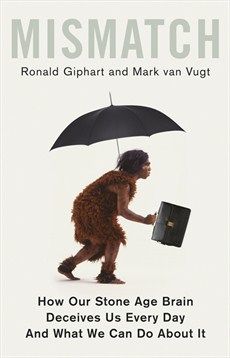Environment
Living in a Digital World with a Stone Age Brain
What could go wrong?
Posted April 21, 2019
We live in a digital world with a Stone Age brain. How does that work out? Well, a lot of my research and blog posts deal with exactly that issue. Why do we prefer taller political leaders? Why might disgust affect our political preferences? Or why do they give out those silly “I voted” stickers?

A book published last year, Mismatch: How Our Stone Age Brain Deceives Us Every Day and What We Can Do About It, provides a thorough but accessible explanation of one of the forces that drive these strange effects. That force is called “evolutionary mismatch."
Mismatch was written by Ronald Giphart, an award-winning Dutch writer, and Professor Mark van Vugt, a widely published evolutionary psychologist at VU University Amsterdam and fellow PT blogger.
MORE MISMATCH DETAILS PLEASE
Here’s the mismatch problem in a nutshell. Modern humans must navigate an anonymous but densely populated, digitally dependent world with a brain molded starting millions of years ago in small hunter-gatherer groups composed of family and friends who roamed sparsely populated, open grasslands.
This is mismatch, which Giphart and van Vugt define more succinctly as occurring when “as the result of a change in the environment, the survival and reproductive chances of [a] particular species’ individuals diminish” (p. 4) or “when species are faced with a rapidly changing environment to which their hardware and software – their body and mind – are not well adapted” (p. 18).
In particular, Mismatch details how modern humans’ bodies and minds are tuned to the physical and social situations that our ancestors found themselves in between 2.5 million to 10,000 years ago. During this period, known as the “environment of evolutionary adaptation” or EEA, our ancestors had to survive a variety of menacing threats including “famine, spiders and insect bites, large predators, much internal violence, and high baby and infant mortality” (p. 59). Because the process of evolution is almost imperceptibly slow, our brains are still well-suited for the EEA.
THE "BIG BANG FOR HUMANITY"
About 10,000 years ago, though, our ancestors initiated an agricultural revolution in which they began to farm and permanently settle land and to domesticate animals. This “Big Bang for humanity” resulted in crucial changes to the physical and social environments our predecessors faced. For instance, family and community groups increased in size as food became more available, and excess food production promoted the emergence of trade.
Sometimes these changes were adaptive (i.e., promoted survival and reproduction), as in larger families and expanding populations, and sometimes they weren’t. Sticking with the food example, despite the abundance and variety of foods today, we humans show a preference for sweet and fatty foods. In current times these are often unhealthy, but long ago they promoted survival among our ancestors when food was hard to come by and when consuming high-calorie foods made it more likely an individual would have the energy to survive to the next meal.
SOME IMPORTANT PROBLEMS
What are some of the evolutionary mismatches that create problems for modern humans? First and foremost is “a crazy little thing called love.” Other mismatches involve work-life imbalance (our ancestors did not have to work day and night to survive), climate change, and virtual reality.
Caveman politicos, though, may be particularly interested in mismatches regarding leadership and war.
Leaders
Giphart and van Vugt starkly report that “those in prehistory who followed the wrong leader with the wrong characteristics simply did not leave any offspring” (p. 167). The “right” leader in prehistory knew that decisions had life and death consequences, built trust in followers using face-to-face interactions, and was obliged to quell violence inside and outside the group, often relying on physical prowess.
And the vestigial lessons internalized from prehistoric leaders dredge up the modern use of obsolete cues to leader quality such as a preference for physically formidable (e.g., taller and heavier) leaders who could, if necessary, stanch violence with violence. Of course, this is the mismatch: modern leadership is not death-defying, personal, or physically demanding. It’s farcical to imagine Donald Trump, Barack Obama, or any of their immediate predecessors, or even not-so-immediate predecessors, personally leading forces onto an exploding battlefield in Syria or stepping in between clashing rioters in Portland.

War
Warfare presents another mismatch. In ancestral times, warfare primarily consisted of close-up, small-scale raids and ambushes. By some accounts, warriors were motivated by the pursuit of greater social status and more sexual partners. The sticky lessons internalized were victorious warriors gained more group friendships and exchange partners and, indeed, access to a larger pool of available female partners in newly acquired territory. And success on the battlefield sent a signal to potential sexual partners of physical prowess and desirable genes that could be passed on to offspring.
The mismatch in this case is that in the modern context male-dominated violent conflict fails to take advantage of the full population of potential warfighters by mostly excluding female fighters. And it results in increasing lethality. Wars fought at a technologically safe distance leave combatants less exposed to the brutal nature of their actions and, as a result, less able to empathize with the suffering their enemies experience on the battlefield.
HOW ABOUT YOU?
People vary in the amount of mismatch they experience. Want to know how well you navigate this digital world with your Stone Age brain? To find out, take the "The Mismatch Test," a non-scientific but fun quiz from Mismatch. (Shhhh...I scored 17.)
Take "The Mismatch Test" Here
And if you want to learn more about evolutionary mismatch, check out Giphart and van Vugt’s entertaining and informative book.
References
Giphart, Ronald, and Mark van Vugt. 2018. Mismatch: How Our Stone Age Brain Deceives Us Every Day and What We Can Do About It. Robinson, 2018.




